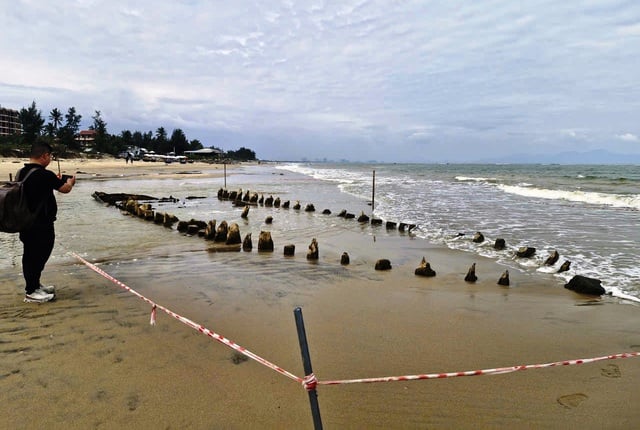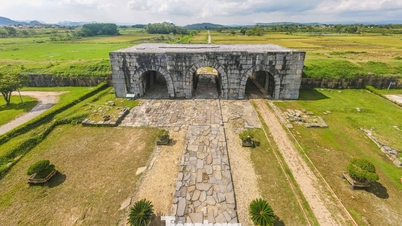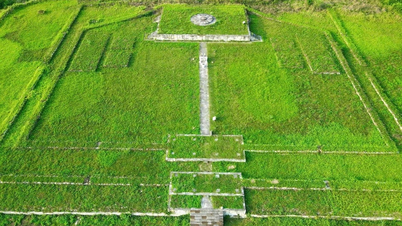On the morning of November 20, the Department of Culture, Sports and Tourism of Da Nang City held a consultation seminar on plans to protect and excavate ancient ship relics that have recently reappeared in the coastal area of Hoi An (Hoi An Tay Ward, Da Nang City).
Extremely rare discovery
According to a report by the Hoi An Cultural Heritage Management and Conservation Center, the ancient ship was discovered by local people at the end of 2023 when the Thinh My coast was severely eroded, pulling sand and soil hundreds of meters out to sea.
By February 14, 2024, many of the ship's wooden structures were clearly visible, measuring 4.7 m wide and 16.15 m long. Large braces with drilled holes, connected by iron pins, showed sophisticated shipbuilding techniques.

The seminar had the participation of many experts and scientists.
PHOTO: MANH CUONG
In June 2025, the ship was again briefly exposed and then buried again. After a storm in early November 2025, the coastline eroded severely, causing the upper part of the ship to almost completely appear. On November 8, the ship was clearly visible with a width of about 5 m and a length of 17.4 m, most likely longer because part of the hull was still under the sand.
Professional agencies assess this as an exceptionally rare discovery, of great value for research on maritime history and cultural heritage of the Central region.
In May 2024, the Hoi An Center for Cultural Heritage Management and Conservation coordinated with the University of Social Sciences and Humanities, Ho Chi Minh City, and Quang Nam Museum to conduct surveys, collect samples, and appraise.
The results showed that the discovery site was on land 700-800 m from the water's edge in 1905; the sediment sample did not preserve pollen, proving that the shipwreck was in a marine environment.
The ship was crafted from at least three types of durable wood including Lagerstroemia, Acacia, and Pine; its sturdy structure bears the mark of a combination of Southeast Asian and Chinese techniques.

Ancient ships are fenced for protection
PHOTO: MANH CUONG
Although C14 dating results are not yet complete, available data suggest that the ship likely dates from the mid-late 14th to the 16th century.
This is considered one of the very few ancient ships that is still relatively intact in the Central region, with outstanding value in the research of the heritage of Quang Nam ships and the history of Hoi An commercial port.
The area where the ship was discovered is only about 20 meters from the water's edge, and is heavily affected by high tides and sea erosion. The ship is constantly being silted up and then resurfaced, facing the risk of serious damage if left exposed to the elements. In addition, the emergency anti-erosion embankment project on the Hoi An coast may directly affect the scene.
Faced with that situation, the Hoi An Center for Cultural Heritage Management and Conservation proposed allowing urgent excavation and urgent preservation to protect the original state of the ship's hull structure, serve archaeological research and develop a long-term conservation plan associated with sustainable tourism development.
The center proposed using Larsen piles to prevent water, perform rolling separation and parallel conservation - a method that has been effectively applied at the shipwreck sites of Binh Chau 2 (Vietnam) and Seam Ngam (Thailand).
The excavation will be carried out in grids, stripping soil from the hull to the sides and bottom, keeping a protective layer of soil 15-20 cm above the wood surface. When the wood is exposed, it will be covered with canvas to keep it moist, recorded, measured, photographed thoroughly, and reinforced to ensure the shape of the hull during the salvage process.
The excavation period is expected to last 45 days, from December 2025.
Caution in preserving ancient ships
Experts emphasize that the ancient ship relics in Hoi An Tay are important material documents that help in-depth research on maritime history and ancient commercial activities in the Central region. At the same time, they play the role of the only material documents that help in-depth research on ancient economic and commercial activities in the Da Nang - Hoi An region.
Early excavation and conservation not only protects rare heritage but is also in line with the orientation of sustainable cultural and tourism development.
Speaking at the seminar, Ms. Nguyen Thi Anh Thi, Vice Chairwoman of the People's Committee of Da Nang City, affirmed that this is a particularly important archaeological discovery, the first time an almost intact ancient ship relic has been recorded in Da Nang City.

Ancient ships discovered on the coast of Hoi An were dated from the mid-late 14th to the 16th century.
PHOTO: MANH CUONG
The discovery location belongs to the international commercial port space of Hoi An - a world cultural heritage, which used to be the destination of domestic and foreign trading ships, contributing to proving the important role of Hoi An port in the ancient international trade network.
Ms. Thi said that in recent times, the authorities of Da Nang City have promptly implemented initial research solutions. However, the work of preserving ancient ship relics is a complex field, requiring in-depth knowledge, modern techniques and the participation of scientists, researchers, management agencies and local communities.

The ship was crafted from at least three types of durable wood including Lagerstroemia, Acacia, and Pine.
PHOTO: MANH CUONG
The discussion is an important step for the People's Committee of Da Nang City to consider and direct appropriate solutions to protect and promote the value of ancient ship heritage in the coming time.
"All comments and assessments to come up with solutions must be extremely careful, based on scientific grounds, anticipating and resolving all factors that may affect relics, aiming at the goal of preserving the authenticity and longevity of relics," said Ms. Thi.
Source: https://thanhnien.vn/tau-co-phat-lo-o-bo-bien-hoi-an-nguy-co-huy-hoai-neu-cham-can-thiep-185251120115627432.htm




![[Photo] Lam Dong: Panoramic view of Lien Khuong waterfall rolling like never before](/_next/image?url=https%3A%2F%2Fvphoto.vietnam.vn%2Fthumb%2F1200x675%2Fvietnam%2Fresource%2FIMAGE%2F2025%2F11%2F20%2F1763633331783_lk7-jpg.webp&w=3840&q=75)

![[Photo] National Assembly Chairman Tran Thanh Man holds talks with South Korean National Assembly Chairman Woo Won Shik](/_next/image?url=https%3A%2F%2Fvphoto.vietnam.vn%2Fthumb%2F1200x675%2Fvietnam%2Fresource%2FIMAGE%2F2025%2F11%2F20%2F1763629724919_hq-5175-jpg.webp&w=3840&q=75)
![[Photo] President Luong Cuong receives President of the Senate of the Czech Republic Milos Vystrcil](/_next/image?url=https%3A%2F%2Fvphoto.vietnam.vn%2Fthumb%2F1200x675%2Fvietnam%2Fresource%2FIMAGE%2F2025%2F11%2F20%2F1763629737266_ndo_br_1-jpg.webp&w=3840&q=75)









































































































Comment (0)